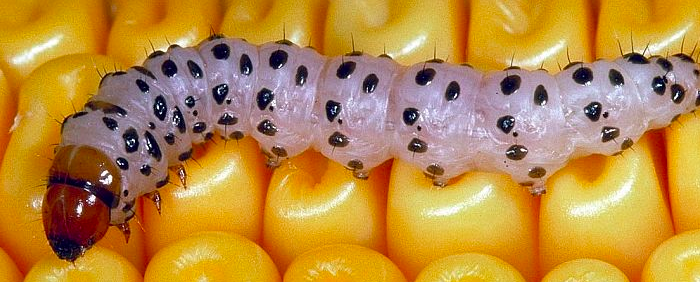
Transgenic maize crops producing Bacillus thuringiensis (Bt) toxins are primarily targeted at a butterfly, the corn borer. These cultures involve monitoring the possible emergence of insects resistant to Bt toxin. The high-dose refuge strategy (HDR), mandatory in the United States and under discussion in Europe, aims to avoid the appearance of this resistance, by promoting genetic mixing in insects. Researchers from INRA and a CNRS-Université Toulouse laboratory studied mating and dispersal of the moths. They show that some mate before dispersal, on a very local scale.
Genetically modified crops corn producing toxins from Bacillus thuringiensis – or cultures “Bt” – are increasingly cultivated worldwide . These toxins, produced in the plant’s tissues, protect them against insects that feed on them. These same toxins, this time produced directly by B. thuringiensis and not by a plant, are also used as conventional insecticides and are included in the list of insecticides authorized in organic farming .The use of Bt crops on a large scale may lead to the selection of resistance in insects, which would ultimately make these transgenic crops, and more generally the use of these toxins, ineffective.
The implementation of a high-dose refuge strategy (HDR), whose aim is to avoid or delay the onset of these resistances, is mandatory in the United States and under discussion in Europe. The HDR strategy requires, inter alia, a coexistence between the parcels of Bt crops and conventional cultures free of Bt toxins – called “safe havens”. Plots of both types should be close enough to ensure genetic mixing between resistant insects – possibly selected in Bt crop plots – and susceptible insects – preserved in refuge areas. Of course, this mixing also depends on the dispersal capacities of the insects and the mating and dispersal.
The corn borer ( Ostrinia nubilalis ), a butterfly whose larvae sometimes infest corn infestations, is the target of several transgenic “Bt” varieties. Recent studies have shown that males and females of this pest are able to disperse over several hundred meters, justifying – a posteriori – the maximum distance, imposed since 2000 by the American legislation, of 800 meters between the plots of corn btand refuge areas. However, these studies did not indicate what order typically occurs in mating and dispersal. However, the genetic mixing is less if the insects of each category – resistant or sensitive – mate locally, the resistant with the resistant and sensitive with the sensitive, before dispersing (even over long distances), that if the two categories begin their adult life with a dispersal phase, and then mate indifferently with individuals, migrants or residents, of any of the two categories.
To better understand the mating and dispersal habits of the moths, researchers from INRA and a CNRS-Université Toulouse laboratory studied their behavior in a spatial configuration identical to that implemented in the HDR strategy. They released and caught butterflies in French conventional corn fields in 2004 and 2005. They were maize moths without resistance to the toxins produced by Bt maize, none of which have been observed to date.
Researchers have observed that immigrant males from other plots are as likely to fertilize a virgin female before it disperses as resident males from the same plot as this female. This observation validates – at least for males – one of the hypotheses of the HDR strategy, since mating at random favors genetic mixing in butterflies. But they also discovered that male and female moths mate regularly before dispersal. Thus, a large proportion (up to 57% of females) of newly hatched moths mate on a very local scale, in the field or edges of the fields in which they emerge, before flying off.
The results of this study indicate that in the HDR strategy – as it is currently implemented in the United States – the genetic mixing between resistant moths – which could be selected in plots of Bt maize – and susceptible borer – from refuge areas – may be narrower than previously imagined. This could reduce the effectiveness of the HDR strategy, at least in some crop rotation configurations.